Kentucky Pesticide Safety Education Program
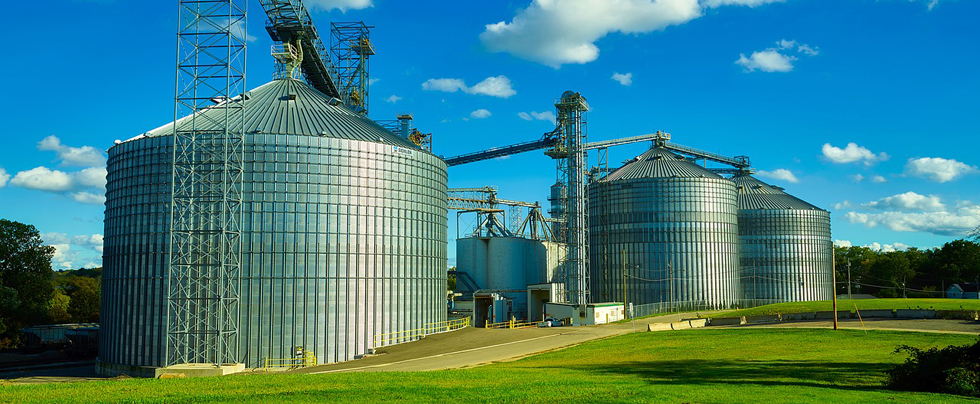
Questions?
Contact
Dr. Ric Bessin
Dept. of Entomology
University of Kentucky
859-257-7450
rbessin@email.uky.edu
Fumigation Safety
Inhalation is the most dangerous and common route of exposure to fumigants. Most are highly toxic so breathing even small amounts can cause serious illness or death. Exposure also can occur thorough your eyes, mouth, or skin. The label will list the personal protective equipment (PPE) that the manufacturer requires. Know what to do in case of an exposure.
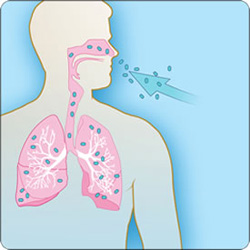
Inhalation is the most common route of exposure to fumigants (levitt-safety.com)
Mild inhalation exposure can cause a feeling of sickness, ringing in the ears, fatigue, nausea and tightness in the chest. Exposure to fresh air will usually relieve these symptoms.
Moderate inhalation exposure can cause weakness, vomiting, chest pain, diarrhea, difficulty breathing and pain just above the stomach.
Symptoms of severe inhalation exposure may occur within a few hours to several days after exposure. Severe poisoning may result in fluid in the lungs. This can lead to dizziness, blue or purple skin color, unconsciousness, and even death.
Do not attempt to rescue someone in an enclosed area if you are not wearing the proper respiratory protection.
A fumigant exposure limit is the highest level of fumigant that you may be exposed to without being required to use any controls to reduce your exposure. You also can reduce your risk of inhalation overexposure by monitoring fumigant concentrations during treatment and aeration. Be sure your exposure stays below established exposure limits.
The three most common terms used to express the exposure limit of a fumigant are the:
Threshold limit value - Time weighted average (TLV-TWA) refers to the average concentration of a fumigant to which most workers may be repeatedly exposed for 8 hours a day, 40 hours a week without adverse effects. Concentrations at or below the TWA represent conditions that you may be exposed to on a daily basis. These levels are considered safe. Concentrations above the TWA may lead to “overexposure” to a fumigant, which can cause discomfort, sickness or even death.
Threshold limit value - Short term exposure limit (TLV-STEL) is the concentration of fumigant to which most workers can be exposed continuously for a short period without suffering from:
- Irritation
- Chronic or irreversible tissue damage
- Narcosis (drunkenness) that may increase the chance of accident or injury
Exposure to concentrations at the STEL should not be longer than 15 minutes and should not occur more than four times per day.
The permissible exposure limit (PEL) designates the maximum exposure permitted as an 8-hour TWA. Refer to the fumigant label information to find out what the different exposure limits are for each product you use.
[return]
Personal Protective Equipment
Personal protective equipment (PPE) is clothing and devices that minimize your exposure to a pesticide. The label lists the minimum required PPE. Federal and state laws require pesticide users to follow all instructions on the product label, including wearing the appropriate PPE.
Respirators
The main types of respirators are:
1) atmosphere-supplying respirators and
2) air-purifying respirators.
They must be approved by NIOSH (National Institute of Safety and Health). The specific type of required may vary depending on applicator health, type of fumigant used, and working conditions. Atmosphere-supplying respirators use canisters to supply breathable air or draw air from outside the fumigation area.
Atmosphere-Supplying Respirators
The two main types of atmosphere-supplying respirators are the self-contained breathing apparatus (SCBA) and the supplied-air respirator (SAR).
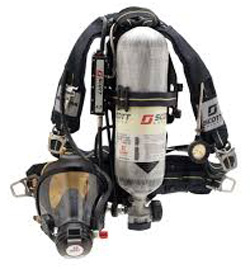
SCBA (photo: scottsafety.com)
Supplied-air respirators have a full-face mask that delivers air from a compressed air tank or an outside air pump. The air tank or pump is located outside the fumigation area.
Air-Purifying Respirators
Air-purifying respirators combine a face piece with a specific filter media. Outside air is drawn into the mask through a filter media. The filter absorbs impurities in the air.
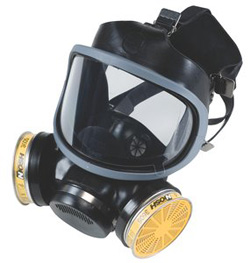
Air purifying respirator (Fastenol.com)
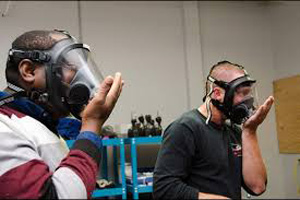
Fit testing respirators (photo: IrwinsSaferty.org)
Respirators should be fit-tested and approved by a licensed health care professional. In addition, be sure that all parts and replacement parts meet manufacturer specifications.
How long a canister will last depends on several things:
- The type of canister
- The size of the canister
- The type and concentration of gas in the surrounding air
- The length of exposure
- The rate of breathing
- Whether there is more than one gas present
- The temperature and humidity at the time of use.
Other Protection Equipment
Fumigant labels also may require other types of PPE, including protective clothing and gloves. Requirements vary so read the label information carefully. Labels recommend loose-fitting clothes, long-sleeved shirts, long pants and socks for skin protection. Others do not specify.
The need for gloves also varies. Applicators must wear gloves because of possible skin irritation some solid fumigants. Labels of liquid products do not require gloves and may prohibit wearing them. Learn which items are required for the product you plan to use.
Whenever possible, provide two-way radio communication between workers applying fumigants and those outside. Also, keep on hand:
- An emergency air-supplying respirator, especially if canister-type respirators are being used
- Antidotes where applicable
- A safety harness or rescue belt
- Basic first aid equipment
[return]
First Aid for Fumigant Poisoning
Human exposure can occur even when you take all of the proper precautions. Unusual behavior by you or your fumigation partner could be a sign of exposure. Know what to do. The label information is your best source of information. First aid procedures on it usually are specific to the product. If you suspect fumigant exposure, remain calm, get to fresh air, and call for help immediately. Take a product label and Safety Data Sheet with you to the emergency room.

CPR (photo: aacc.edu)
If you are with someone suffering from inhalation exposure, carry him or her to fresh air immediately. Then:
Call for help - 911.
Loosen all tight clothing.
Give artificial respiration if breathing has stopped or is irregular.
Keep the victim as quiet as possible.
Prevent chilling by wrapping the victim in blankets. Do not to overheat the victim.
If the victim is convulsing, protect his or her head from striking the floor or wall.
Begin CPR if the victim does not have a pulse. Keep the victim’s chin up so that the air passage remains free. Do not put anything in the mouth of an unconscious person.
Get medical attention right away or take the victim to a doctor or emergency facility.
Liquid and solid pesticides are most often the cause of skin exposure. However, some fumigant gases can injure the skin. Clothing or jewelry can hold the gas against the skin, causing burns or blisters. Fumigants absorbed through the skin can enter the bloodstream, causing systemic effects. Most fumigant labels suggest that you remove all jewelry and wear loose-fitting clothes. Some labels prohibit the use of gloves. Always consult the label to determine what precautions you should take.
If skin exposure does occur, take the following steps:
Get to fresh air.
Remove contaminated items (clothing, jewelry, gloves, shoes, bandages, etc.) immediately.
Drench the skin with water.
Wash the skin, hair and fingernails with soap and water.
Rinse thoroughly and wash again.
Dry and wrap the affected skin in a blanket.
If exposure causes a burn, cover the area loosely with a clean, soft cloth. Avoid using ointments, powders and other medications.
Do not wear contaminated clothes again until you wash and air them for several days.
[return]
Protecting the Public and the Environment
Reading the label is the most important thing you can do to ensure personal and public safety. Labels may include both an abbreviated sticker label and an extended label booklet. It may list specific sites that you should avoid or application methods that are not permitted. There will be storage and specific safety precautions.
Monitoring for the Fumigant
There is always a risk that fumigant gas will escape from a treatment area. Monitoring for these leaks is critical. Be sure to take air samples when treating commodities that are next to work areas. Use appropriate gas detectors to verify that fumigants are not leaking. This is particularly important during indoor treatments.
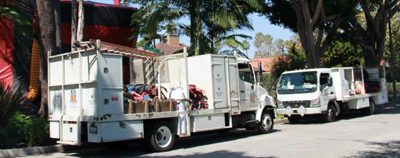
(photo: vikingfumigation.com)
Transporting a fumigant is dangerous. Leaks and spills caused by accidents can be beyond your control.
You can prevent many accidents by taking the following precautions and using common sense.
Do not carry fumigants with people in a closed vehicle and do not take fumigants through tunnels without permission from the Kentucky Department of Transportation (KDOT).
Have the required driver's license with appropriate endorsements for the specific fumigant you plan to transport.
Read the label information and/or the Safety Data Sheet (SDS) to determine the signage requirements for transporting each fumigant that you use. You can also contact the fumigant manufacturer for more information on placarding for transportation.
Be sure cylinders are upright, secured, and protected from rear-end collision.
Do not remove protective valve covers until just before use.
Follow federal and state department of transportation regulations.
NOTE: It is illegal to transport goods over public roads or highways if those goods are undergoing fumigation or have not been completely aerated.
Storing fumigants is hazardous; when possible, buy only what you need. Store fumigants on sturdy shelves in an area apart from feed or seed. A separate building that is well-ventilated or has a mechanical exhaust system is best. Be sure that all fumigant storage areas are locked and posted as pesticide storage sites. Warning signs should indicate the presence of fumigants.
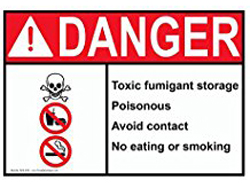
(image: amazon.com)
Check valves and containers regularly for leaks. Fumigants can escape from faulty valves or damaged or corroded cans. Leaks can cause dangerous concentrations to build up in closed storerooms. Before entering any storage area, run an exhaust fan to remove vapors that may have built up inside.
Do not risk contamination of water supplies. Dispose of all empty containers, residues and rinsates according to state waste management procedures. Keep all pesticides and their empty containers out of the reach of children.
Proper aeration is important for the safety of you, your crew, and your clients. Poor aeration is one of the most common problems associated with fumigation. When treating raw agricultural products, be sure the rate of air exchange during the aeration phase will adequately remove the fumigant. If necessary, use fans or other ventilation equipment.
Preparation and planning will help to prevent public and environmental exposure. How well have you sealed an area? Have you inspected all equipment thoroughly? Are you applying the fumigant at or below the label rate? Have you set aside enough time to aerate the site or item completely? Have you set up fences and posted warning signs to keep people, livestock and pets out of the treatment area?
Spilled aluminum or magnesium phosphide may generate high levels of phosphine gas so all personnel must wear SCBAs during the cleanup. DO NOT USE WATER AT ANY TIME to clean up these spills; water speeds up the production of phosphine gas, which could result in the release of toxic gas or produce a fire hazard.
If aluminum flasks have been damaged enough to leak, repair them temporarily with aluminum tape, or transfer the undamaged product to a sound metal container and label it.
Pre-Fumigation and Fumigation Application Procedures
READ AND FOLLOW THE LABEL DIRECTIONS.
Post areas to be treated immediately before fumigation. Use bilingual placarding if workers or neighbors do not read English.
Apply fumigant from the outside where appropriate.
Only allow entry into fumigation area in extreme emergencies, and only with mandatory respiratory protection.
When fumigating, consider prevailing wind and other factors that may affect the fumigation.
Post warning signs.
Provide guards where required. This is necessary unless the fumigated area is completely locked or enclosed by a locked fence.
Post-Application Operations
Provide guards where required and/or necessary.
Allow adequate aeration time for the structure / commodity.
Turn on all ventilating or aerating fans where appropriate.
Before re-entry, use a suitable gas detector to determine fumigant concentration so appropriate precautions may betaken. Most fumigants do not provide adequate odor warning.
Check for gas concentrations in areas that aerate slowly.
Remove warning signs when aeration is complete.
Dispose of empty containers and used canisters.
Return unused chemicals in properly and clearly labeled containers to storage area.
[return]
1) Fumigants are Restricted Use pesticides because of their ______________________.
2) _________ is the most dangerous and common route of exposure to fumigants.
3) __________ inhalation poisoning may result in fluid in the lungs.
4) Exposure to concentrations at the Short Term Exposure Limit should not be longer than ___ minutes and should not occur more than ___ times per day.
5) Threshold limit value - Short term exposure limit (TLV-STEL) refers to the average concentration of a fumigant to which most workers may be repeatedly exposed for 8 hours a day, 40 hours a week without adverse effects.
6) All respirators used for fumigation must be approved by _________.
7) Specific media filters are found in _________________.
- atmosphere-supplying respirators
- supplied-air respirators
- self-contained breathing apparatus
- air-purifying respirators
8) A NIOSH/MSHA approved full-face gas mask with a phosphine canister may be used at levels up to ___ ppm.
9) An approved self-contained breathing apparatus (SCBA) must be worn if the fumigant concentration is unknown.
10) Most fumigant labels require the use of tight-fitting clothing to reduce potential skin injury.
11) It is legal to transport goods that are undergoing fumigation over public highways as long as the vehicle has the proper placarding.
12) Skin burns from a fumigant should immediately by covered with an ointment.
13) Never use water to clean up spilled aluminum of magnesium phosphide.
website content by L. Townsend website design by P. Dillon copyright © 2016 University of Kentucky Department of Entomology
University of Kentucky College of Agriculture |
S-225 Agricultural Science Center North, Lexington, KY 40546-0091 | 859.257.7450
An Equal Opportunity University |
Last modified
11/30/2018
